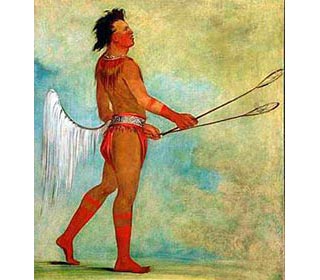The climate, land and natural resources that were available to the Indian tribes resulted in the adoption of the Southeast Native Americans culture. - Name of Group: Southeast Native Americans - The Five Civilised tribes
- Languages: Siouan, Algonquian, Caddoan, Uto-Aztecan and Athabaskan
- Geography of the State of Southeast Native Americans: River Valleys, mountains and swamps
- Animals: Rabbits, wild hogs, turkeys, eagles, opossums, raccoons, squirrels and deer
- Natural Resources: Corn, beans, dried fruit, pumpkins and nuts
- Culture and Lifestyle adopted: Nomadic Hunters, Fishers and farmers
- Clothing: Deerskin clothes, rabbit fur and porcupine quills
- Transport: Canoes
- Art: Pottery and baskets
- Types of housing, homes or shelters: Asi Wattle and Daub houses
- Famous Tribes of Southeast Native Americans: Natchez, Cherokee, Chickasaw, Choctaw, Creek and Seminole
- The Native Indians who lived on the borders of lands often reflected two different types of lifestyles
Southeast Native Americans - Languages
The languages of the Southeast Native Americans included Siouan, Algonquian, Caddoan, Uto-Aztecan and Athabaskan Southeast Indians - Physical Characteristics
The physical characteristics of Southeast Indians are dark brown eyes, prominent cheek bones, straight black hair, and scantiness of beard. The skin color of Native Indians varies from very light in some tribes such as the Cheyenne, to almost black in others, such as the Caddo and a yellowish color in such as the Flatheads.
Southeast Native Americans - Geography and Environment
The Geography and Environment can be generally described as a humid, fertile agricultural region. The region offers mountains, rivers and forests in the north and grasses and swamps in the south including the Everglades swamp in what is now the State of Florida. The climate is hot in the summer and mild in the winter.
Southeast Native Americans - Animals
The animals were very important to the Southeast Native Americans. The animals available to the Southeast Indians included rabbits, wild hogs, turkeys, eagles, opossums, raccoons, squirrels and deer. The uses of the animals were varied and included food, clothing, shelter and decorations. Southeast Native Americans - Food
The food eaten by the Southeast Native Americans included corn bread, hominy grits, tomatoes, potatoes and sweet potatoes. Turkeys also supplemented their diets.
Southeast Native Americans - Houses, Shelters and Homes
The different types of Houses, Shelters and Homes depended on the materials available and whether the home was permanent or temporary. The homes of the Southeast Indians included Wattle and Daub houses and chickees. The Seminole tribes often lived in small villages consisting of chickees, a communal eating house and storage facilities.
Southeast Native Americans - Religion, Ceremonies and Beliefs
The Religion, Ceremonies and Beliefs were based on Animism. Animism was a commonly shared doctrine, or belief, of the indigenous people of North America and Canada including the Southeast Indian tribes. Animism is based on the spiritual or religious idea that the universe and all natural objects have souls or spirits. In this religion it is believed that souls or spirits exist not only in humans but also in animals, plants, trees, rocks etc. This belief is also extended to natural phenomena such as thunder storms and rain and geographic features such as mountains, caves or rivers also possess souls or spirits. Tricksters feature in the legends and mythology of the Southeast peoples as do heroic figures or "transformers" who transform, or change, the world into its present state. They also have stories about councils of animals. Southeast Native Americans - The Shaman
The Religion, Ceremonies and Beliefs of the Southeast Indian tribes were also dominated by Shamanism in which a religious leader called a Shaman acted as a medium between the visible and spirit worlds. Southeast Native Americans - The Green Corn Festival
The Green Corn Festival was one of the most important ceremonies of the Southeast Indians. The festival was celebrated in the fall. Chanting shamans and dancing warriors circled a cooking fire, carrying corn as can be seen by the above picture. After cooking the corn it was presented as a sacred offering to the Great Spirit. A new fire was built and enough corn for the entire village was made whilst people danced in celebration. |
